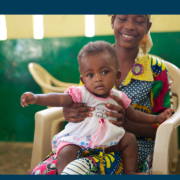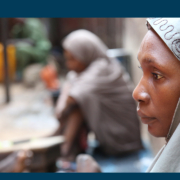In Honor of World Breastfeeding Week: Interpreting Baby’s Cries
Written by: Eirene Wang, Nicole Russo, and Emily Zimmerman, Breakthrough ACTION
The World Health Organization estimates that increasing rates of breastfeeding could save more than 800,000 lives every year. Exclusively breastfeeding for six months significantly reduces the incidence of malnutrition, diarrhea, and a range of other illnesses in infants and mothers. Yet nearly 2 out of 3 infants are not exclusively breastfed for the recommended length of time—a number that has held firm for the last two decades.
In honor of World Breastfeeding Week, Breakthrough ACTION is sharing insight from the Democratic Republic of Congo (DRC) where the project has been implementing qualitative research using a behavioral economics approach. This research identified several reasons why mothers do not always practice exclusive breastfeeding, which opens up new avenues to ensure that more infants reach this important milestone.

Mother receives counseling while holding her twins in the Democratic Republic of Congo. Photo credit: Breakthrough ACTION
One insight from Breakthrough ACTION’s research relates to the changing cues mothers see in their babies’ cries as they grow. Mothers in Lualaba, DRC explained they know their babies are hungry when they cry and they always respond by breastfeeding. However, mothers also reported their babies’ cries changed when they were 3–4 months old. This change is well-documented in research on early childhood development, which shows as babies grow they become more aware of their environment and start to express a greater range of emotion through crying. As this happens, their cries become more frequent and insistent. While the mothers in Lualaba noticed this change in how their babies cried, they continued to interpret cries as always communicating hunger. When they were not able to soothe their crying baby with breastmilk, they reasonably mistook those cries as a cue that their baby must need some other form of nourishment. This led mothers to offer porridge or water before six months.
This insight suggests that, while showing mothers the benefits of exclusive breastfeeding and the risks of offering porridge and water may be important, it is unlikely to change their behavior unless another, seemingly separate challenge is addressed: how to soothe the increasingly varied cries of a growing infant. Breakthrough ACTION is currently developing a suite of solutions that works across multiple touchpoints to address this barrier and others identified through formative research. These solutions will help more women practice exclusive breastfeeding for six months, contributing to long and healthy lives for both mothers and their babies.

 Pitshou Budiongo
Pitshou Budiongo Sara Holbak/VectorWorks/Photoshare
Sara Holbak/VectorWorks/Photoshare

 2019 CORE Group Global Health Practitioner Conference
2019 CORE Group Global Health Practitioner Conference Breakthrough ACTION
Breakthrough ACTION Photo credit: amy Rakotoniaina/PMI/Flickr
Photo credit: amy Rakotoniaina/PMI/Flickr